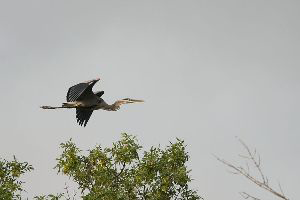Although most great blue herons feed in water on fish and other aquatic animals, some develop individual habits, specializing in amphibians or hunting in fields for small mammals and reptiles. Special neck vertebrae allow great blue herons to curl their neck into a tight "S� shape, which enables a very quick and powerful strike at prey.
Photo Credit: Dori via Wikipedia Commons
Ardea herodias
Common Name: great blue heron
Other Common Names: shikepokes, shitepokes
Animal Guild: Bird
Class > Order > Family: Aves > Pelecaniformes > Ardeidae
What does the species look like?
This is the largest North American heron, reaching 1.6 meters (5 feet) tall with a wingspan of 1.8 meters (6 feet). The back, neck, and wings are blue-gray, and the throat is white with streaks of black. The head is white with a black stripe above the eye that extends into a crest in males. The great blue interbreeds with the all-white great white heron in southern Florida, producing offspring called Wurdemann's heron with a dark body and white head and neck.
Where is the species found?
States & Provinces
AB, AK, AL, AR, AZ, BC, CA, CO, CT, DC, DE, FL, GA, IA, ID, IL, IN, KS, KY, LA, MA, MB, MD, ME, MI, MN, MO, MS, MT, NB, NC, ND, NE, NH, NJ, NL, NM, NS, NV, NY, OH, OK, ON, OR, PA, PE, QC, RI, SC, SD, SK, TN, TX, UT, VA, VT, WA, WI, WV
Distribution
The breeding range extends from southern Canada and coastal British Columbia southward through the United States (except the high Rockies and driest southwest deserts) to southern Mexico. The winter range includes much of the United States and extends southward through Mexico, Central America, and the northwest and northeast coasts of South America.
Great blue herons forage in most wetland types including marshes, ponds, lakes, streams, rivers, estuaries. Some individuals will forage away from water, in fields, quarries, and grasslands. Most nesting colonies are in trees, but some are on the ground or sometimes on artificial structures. Nesting colonies are often located in isolated swamps or on islands that are not readily observable.
General Phenology and Life History
Great blue herons nest as single or few pairs, but most nest in large colonies that may number in the hundreds. Some herons roost in the vicinity of nesting colonies all year, but many arrive at colonies in spring, shortly before egg-laying begins. Commencement of breeding varies across the range; adults begin arriving at colonies in December in California but not until March at interior sites such as Alberta, Canada. The timing of egg laying also varies throughout the range, occurring from late February in California to late April in Alberta, Canada. Clutch size is 3-7 and averages larger in the north than in the south. Incubation, by both sexes, lasts 25-29 days. Both parents tend the young. Young become conspicuous within 2 weeks of hatching and depart the nest at an age of 2-3 months. Adults and fledglings begin leaving the nesting colonies in late August, migration begins in late September, and populations are usually gone from the north by mid-to-late November. Great blue herons migrate away from areas where open water is not available during the winter.
Which phenophases should I observe?
Do you see/hear...?
Activity
Live individuals More...
For abundance, enter the number of individual animals observed in this phenophase.
Feeding For abundance, enter the number of individual animals observed in this phenophase.
Calls or song For abundance, enter the number of individual animals observed in this phenophase.
Territorial individuals For abundance, enter the number of individual animals observed in this phenophase.
Reproduction
Courtship For abundance, enter the number of individual animals observed in this phenophase.
Mating For abundance, enter the number of individual animals observed in this phenophase.
Nest building For abundance, enter the number of individual animals observed in this phenophase.
Occupied nest For abundance, enter the number of individual animals observed in this phenophase.
Development
Nestlings For abundance, enter the number of individual animals observed in this phenophase.
Fledged young For abundance, enter the number of individual animals observed in this phenophase.
Dead individuals For abundance, enter the number of individual animals observed in this phenophase.
Dead nestlings or fledglings For abundance, enter the number of individual animals observed in this phenophase.
Method
Individuals at a feeding station For abundance, enter the number of individual animals observed in this phenophase.
What do these phenophases look like?
There is currently no photoguide available for this species. If you'd like help us create one, use the guidance document and species template provided here . Then send it via email to education@usanpn.org when it is complete.
